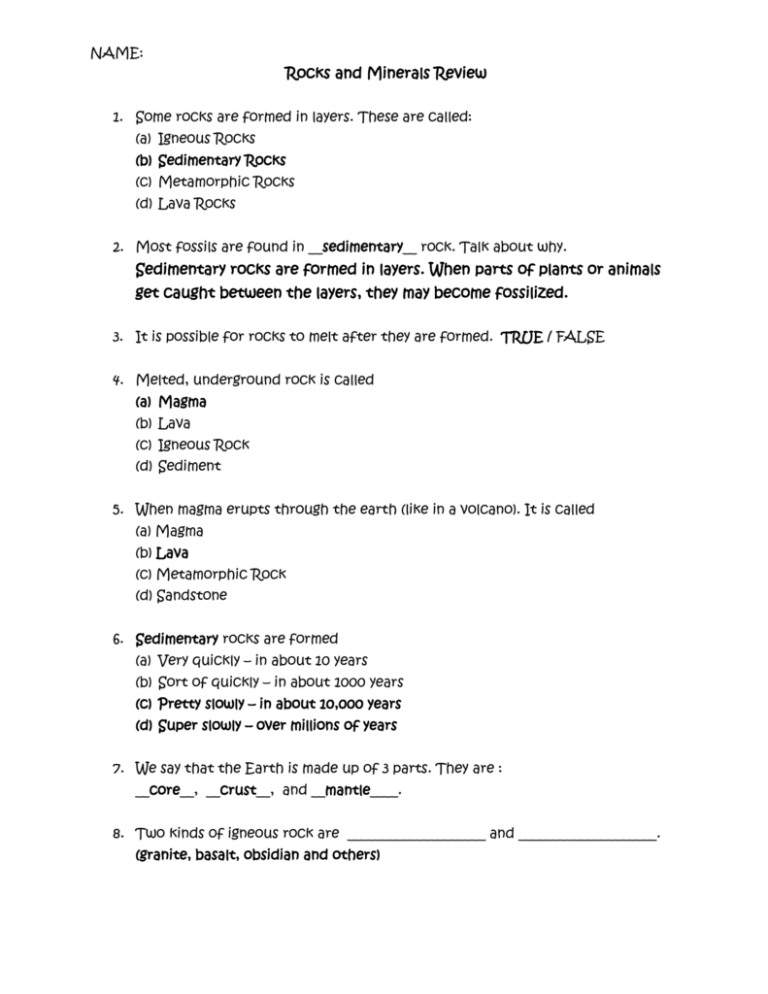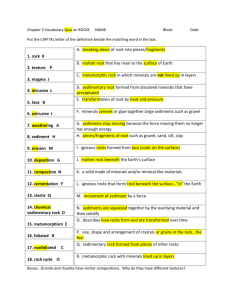NAME: Rocks and Minerals Review Some rocks are formed in layers
advertisement

NAME: Rocks and Minerals Review 1. Some rocks are formed in layers. These are called: (a) Igneous Rocks (b) Sedimentary Rocks (c) Metamorphic Rocks (d) Lava Rocks 2. Most fossils are found in __sedimentary__ rock. Talk about why. Sedimentary rocks are formed in layers. When parts of plants or animals get caught between the layers, they may become fossilized. 3. It is possible for rocks to melt after they are formed. TRUE / FALSE 4. Melted, underground rock is called (a) Magma (b) Lava (c) Igneous Rock (d) Sediment 5. When magma erupts through the earth (like in a volcano). It is called (a) Magma (b) Lava (c) Metamorphic Rock (d) Sandstone 6. Sedimentary rocks are formed (a) Very quickly – in about 10 years (b) Sort of quickly – in about 1000 years (c) Pretty slowly – in about 10,000 years (d) Super slowly – over millions of years 7. We say that the Earth is made up of 3 parts. They are : __core__, __crust__, and __mantle____. 8. Two kinds of igneous rock are ____________________ and ____________________. (granite, basalt, obsidian and others) NAME: 9. Another word for layers is (a) Strata (b) Sedimentary rock (c) Sand (d) None of these 10. Igneous rock that forms when hot magma cools inside the earth is called INTRUSIVE / EXTRUSIVE rock. 11. It is extremely hot inside the earth. TRUE / FALSE 12. Describe the four features of minerals. 1. luster 2. cleavage 3. colour 4. hardness 13. Lava is a metamorphic rock. TRUE FALSE 14. The word metamorphic means: (a) Very hard (b) “Changed” (c) Under pressure (d) “Inside the earth” 15. Metamorphic rock is formed when hot magma slowly gets force into different types of sedimentary rock with great heat and pressure. Name 1 type of sedimentary rock and tell what kind of metamorphic rock it becomes. limestone - marble ; shale - slate ; sandstone - quartzite 16. Quartzite, slate and marble are examples of what type of rock? metamorphic 17. Parts of earth’s crust are constantly moving around on a bed of hot, liquid magma. These are called (a) Tectonic Plates (b) Continents (c) Countries (d) Volcanoes NAME: 18. Granite is a type of: a. Igneous Rock b. Sedimentary Rock c. Metamorphic Rock d. Coal 19. Minerals are used by people for many purposes. Pick any one of the six minerals we tested in class and describe what we use it for (2-3 uses) See "Uses of Minerals" sheet. 20. Minerals are ORGANIC / INORGANIC substances, which means they were never alive. 21. Pick any kind of rock and talk about how it is formed. Sedimentary: formed in layers, built up usually in bodies of water over thousands of years. Igneous: Formed by the cooling of magma either inside the earth's crust (intrusive) or outside, usually resulting from a volcanic eruption (extrusive) Metamorphic: means changed or transformed. Sedimentary, igneous or metamorphic rock may undergo extreme heat and pressure and be changed into a different kind of rock. 22. Describe Mohs' scale for minerals: Scale is developed to rank the hardness of minerals. Talc (1) is the softest and diamond (10) is the hardest substance on earth. 23. Rocks are constantly formed and re-formed in something called: a. Eruption b. The Rock Cycle c. Weathering d. Sedimentation 24. The hardest substance on Earth is: a. Diamond b. Rock c. Emerald d. Steel NAME: 25. Define the word ORGANIC and give 3 examples of organic substances. Organic means 'living' or 'once living'. Any substance that is or was ever alive is considered organic. 26. Define the word INORGANIC and give 3 examples of inorganic substances. Inorganic means non -living. Any material that is not or never was alive is considered to be inorganic. 27. Wind and water act on rocks, causing them to change shape and break apart. This is called: a. Eruptions b. The Rock Cycle c. Weathering d. Sedimentation CLASSIFYING MINERALS There are as many as 3,000 known minerals on Earth, and more are being discovered all the time! Geologists classify minerals in many ways. What do these classifications mean? LUSTRE: Luster means how shiny a mineral is. It can be described as dull, glassy, waxy, or metallic. CLEAVAGE: Cleavage refers to the way a mineral breaks. All minerals have a distinct pattern that they break into- usually into geometric shapes. TRANSPARENCY: How easy it is to see through a mineral. Minerals can be opaque (impossible to see through), translucent (somewhat clear), or transparent (see-through) HARDNESS: The hardness of a mineral is determined by the Mohs scale of hardness. Minerals are given a number from 1 (softest) to 10 (hardest).









